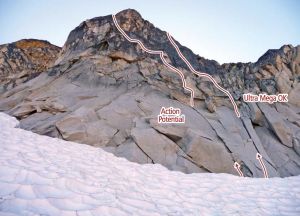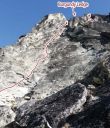Ultra Mega OK, Burgundy Spire III+ 5.11a |
||
Washington Pass, Washington, USA | ||
| ||
|
Avg time to climb route: 4-8 hours
Approach time: 3-5 hours Descent time: 3-5 hours Number of pitches: 9 Height of route: 800' Overview
This is a newer and adventurous route on mostly solid rock. It’s a big step up in difficulty from Action Potential because the climbing is harder, the route finding more challenging and there are more runout sections. The position and the finish are awesome and the cruxes are well-protected. You can pull through the hardest sections on gear but there is a lot of easier 5.10 and 5.9 moves a short ways above your gear on dirty, lichen-covered rock. Be solid at 5.10+ or 5.11a for this route.Climber Beta on Ultra Mega OK
Find other routes like
Ultra Mega OK
Route History
Tom Smith and Mark Allen made the first ascent on July 24, 2004. Smith and Allen saw the line during the second free ascent of the East Face via Action Potential on July 22 (only three days after that routes first ascent).On July 24, after consuming jet fuel (coffee), at the Mazama Store, Allen and Smith left the Highway on the approach at 7:30 am. Allen and Smith started up Pitch 1 of an independent line, barely ten feet to the right of Action Potential’s first splitter pitch. The two routes shared the first belay. They trundled few rocks and began climbing a chimney that was followed by a right-facing corner. The system continued via hand and finger cracks as predicted by their previous scouting. Then, an unexpected difficulty. They stood on a ledge below an open book seam leading to a double-roofed hand-to- fist crack with changing corners. Lichen made it very difficult to free climb. Smith aided the seam and freed the difficult roofs at 5.10c/d. As the second, Allen was able to free the newly cleaned seam and concluded that it should be 5.11ish. Allen and Smith continued to discover finger and hand crack systems made more exciting by great exposure and position to the glacier below. They followed the system with enthusiasm, stoked by views of Vasaliki Ridge and the Silver Star Glacier drainage. Smith led the amazing last, spicy pitch and topped out on Burgundy’s north shoulder joining the Original Route (Becky, Hane, Parrott, 1953) for a few final pitches to the summit block which he reached at 8:30 p.m. Allen said, “I was amazed at the quality of another unclimbed line on Burgundy East Face.” After making it to the summit, they rapped down to Burgundy Col. The route was done car-to-car, free of tat or bolts. Two Lost Arrows were placed at the crux belay and one remains. Strategy
Crowds are unlikely. There is a fair bit of loose rock, and you would not want to climb under another party.The route starts less than ten feet to the right of Action Potential, up a twin splitter crack system on very clean granite. After 100 feet, you reach a small ledge and the top of Pitch 1. This is also the same belay station as Action Potential. The next pitch starts up a dirty chimney with good gear leading to a splitter .75-1” crack, followed by more blocky climbing, some splitter cracks and the belay. The next pitch ascends funky, loose looking but fairly solid blocks. While these blocks look fairly solid, take care not to dislodge one on your partner below. Climb past these blocks to a short under-cling leading to the belay at the triangle ledge. From here there are two options. The first and original route ascends the thin 5.11a corner. This pitch protects with small nuts and very small cams. It has some difficult stemming on lichen-covered rock, but climbs straight into a roof with a wide crack. The other option is to climb left to the next corner. This pitch is also very lichen covered, but takes smaller cams better. It is also a little easier in the corner (5.10c/d), but has a couple of well-protected face moves (5.11a) to gain the wide crack slightly higher than the roof. Climbing in this steep, big hands to big finger crack is quite fun and ends on a sloping ledge. From here, the route finding gets even more challenging. Work your way up cracks and face on some slightly spicy climbing with small runouts toward a large roof. This roof appears very difficult but goes around 5.9+ pulling over the bulge. This is a long pitch and many climbers will choose to break it into two pitches. The final pitch before joining the 1953 Northeast Face Route starts on the East Face before crossing over onto the North Face near a flake about halfway up the pitch. This pitch is a little runout on 5.8 and 5.9 terrain but never too bad. The large ledge on the shoulder of Burgundy Spire is where Ultra Mega OK and Action Potential join the original 1953 Northeast Face Route. You can down climb and finish on the more commonly climbed Northwest Face, but climbing the 1953 ridge is a super fun way to end the route. Stay on the ridge, passing an old bolt with an exposed 5.8 move. Parties finish the ridge from here in two to four more pitches, depending on rope drag, on mostly moderate climbing. You essentially traverse all the way across the summit ridge. There are a few exposed step-across moves and some short down climbs. You’ll pass underneath the summit on the north side of Burgundy before you can climb up to the summit. Climbers should rap down the normal North Face descent to Burgundy Col. Don’t leave anything at the base because it is a big pain to go back and get it. There is typically a short section of steep snow (35- 40 degrees) getting to the base. Depending on the year, many climbers take aluminum crampons for their approach shoes and use rocks to chop steps and assist with balance. Retreat Storm
There are a few random bail anchors and fixed nuts, especially on the first few pitches. Once above Pitch 4, retreat becomes more difficult and scary as there is a lot of loose rock you could knock down and many flakes for your rope to catch on. Retreating from most places on the route means leaving gear; having two ropes means leaving less gear.
Everything You Need to Know About
Washington Pass
Search the internet for beta on
Ultra Mega OK
|
Other Routes on Burgundy Spire
|


